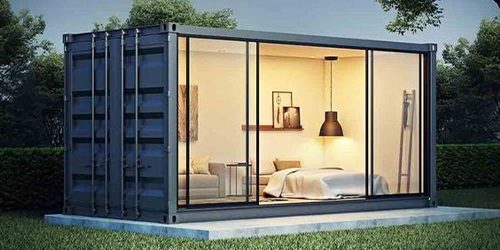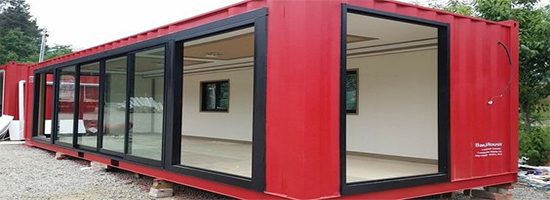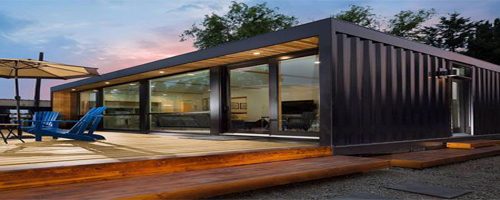More and more people prefer using shipping containers to build houses, offices, gyms, hostels, and more. This is because shipping containers are affordable, energy-efficient, durable, and very flexible.
If you are thinking about building or purchasing a container home, it is important that you have the right information to avoid any serious problems during the process. You can learn about the basics, such as the costs and what you need to do in this guide for shipping container homes.
But, if you are looking for specific answers, then you can browse through our FAQs. We have compiled the most commonly asked questions regarding shipping container houses.
Both container houses and tiny houses are growing in popularity today. These houses offer personalized living, affordability, and are ideal for those who follow a minimalist lifestyle. But, they also have their differences:
Space Comparison
While both the regular tiny house and container house can be designed according to your taste, a container house does not need to be tiny. It can be extended, such as connecting two shipping containers, to make them more spacious for those who will occupy it. Meanwhile, a tiny house can be designed in different ways but will still have limited space.
A standard tiny home is about 8.5’ x 24’ in size, although some are smaller or bigger depending on the number of occupants and the budget. A shipping container is typically 20 ft. to 40 ft. long, but can become bigger and longer by joining another container to build a home with a size ideal for the occupants.
Cost Comparison
For both container and tiny house, the starting cost is about $40,000 USD. The price will go up if there are additional specifications, bedrooms, and spaces.
If you are planning to build you a house of your own design, the costs will depend on various factors. These include the materials you will use and the design of your home. A single shipping container costs around $2,500 USD. You should consider the consents, design, materials, engineering, and labor costs on top of the estimated cost.




Sustainability and Energy Efficiency
Using a shipping container for your home is a great way to live sustainably. The level of sustainability of both a container home and a tiny home will depend on the materials used to build them. A smaller space will require fewer materials and will have lesser energy costs. Both of these homes can be assembled on-site, which decreases the travel time required and ultimately, reduces your carbon footprints.
Renovation
When it comes to renovation, both types of homes have their own advantages and disadvantages. A container home can be extended due to its modularity. This means you can definitely achieve the ideal space for you and the other occupants of the home. However, roofing work, specialized building process, and insulation can be complicated.
Also, in container homes, recycling can be hard work, such as removing toxins and rust. However, after all the work is done, it will definitely be worth it. A container home is durable, can withstand severe weather conditions, and can last for a very long time.
In comparison, a tiny home cannot be expanded but still has a lot of benefits. You can choose a wide selection for the materials and the design. According to your budget, you can design your home in a way that makes it more spacious.
You can expect a container home to last at least 25 years without any issues. If you maintain it properly and keep watch of rust attentively, you can expect it to last even longer. Also, if you cover it with an external layer, i.e., wood, then it can last for a really long time.
The exact cost needed to build a container house will vary. In general, a house made from a shipping container costs between $1,400 USD to $4,000 USD and will depend on the age, condition, and size of the container. To give you some idea, here are some of the prices for the most used shipping containers when building a home:

In addition, the more customization you add to your house project, the more money is going to be involved. Features such as plumbing, electricity, floors, and windows will cost around $50 USD to $150 USD hourly in contractor fees.
Other factors that also affect the cost are:
A large house made from shipping containers can cost from $150,000 USD to $175,000 USD. Whereas, if you have experience in construction and plan to build it yourself, it will cost you as low as $10,000 USD.
To learn more about the costs involved in shipping container houses, you can check this post that gives in-depth information about shipping container home costs.
No, shipping containers are not waterproof. However, they are water-resistant, which means they can resist water to some degree. They can keep precipitation, rain, and snow out of the home.
If you are buying a new shipping container house directly from a manufacturer, you can be assured that it is safe. You simply have to inform the manufacturing company to not coat and treat the floors with hazardous paint.
However, if you purchase a second-hand shipping home, there is a chance that it might have been treated with chemicals. If that is the case, there are two ways to address this situation. First, you can put a non-breathable flooring underlayment over the flooring directly. Second, you can remove the original flooring entirely and replace it with a new one, like marine plywood for example.

Shipping container houses are built to be strong and durable so they can endure storms and high winds up to 100 mph. They can even be safer and more secure if they are attached to a solid foundation, which allows them to endure winds up to 175 mph.
If you are thinking about getting a shipping container home but live in a place with extreme weather conditions, such as tornadoes or hurricanes, you can be assured that your container house is completely safe.

Yes, shipping container homes need a foundation so they will have a stable and solid platform. Even though it usually goes unnoticed, the ground moves to a certain degree. This movement can be slow and irregular but can cause the ground to slide, sink, or, rise. Having a solid foundation can prevent your container home from separating or splitting.

The overall cost of building a 2-story prefab home will depend on several factors, including the materials to be used, where you are building it, and the customizations you want to add. But, to give you an estimate, the starting cost of an average 2-story prefab home is about $145,000. It will cover 1,500 to 4,000 square feet and will take an average of 14 to 24 weeks to make.
Yes, it is possible to build a tiny home within a 50k budget, but it will require you to do most of the work, particularly finding materials and building the house itself. Also, the materials you are going to use must be at discounted prices directly purchased from building supply companies.
The first thing you need to do is to check whether your area allows the construction of container homes. Building permits are required so you can comply with the building codes of both local and state authorities. On average, a person spends about $398 to $1561 for building permits. Before anything else, make sure to contact your local zoning board to learn what is allowed and what’s not.
When it’s confirmed that you can build a container home in your area, it’s time to look and purchase the container itself. When doing this, make sure to consider your needs and resources so you can pick the right type and size of the shipping container. Also, it’s imperative that you inspect the container firsthand before buying. Remember, know everything about what you are buying to avoid unnecessary problems and costs in the future.
It takes careful planning and brainstorming when designing a container house. The most important things to consider are your needs and who will live in the house. There are a lot of container home designs that you can choose from. Think about what you like and need and find the best design that suits them.


When designing your container home, it’s best that you consider the style that is most practical. For example, if you are living in an area that is prone to floods, then it’s an excellent idea to build your home on Asian-style stilts. Meanwhile, if your area is consistently hot, then it’s good to have a subterranean home.
Here are some great designs to inspire you:
A shipping container home with a modern design is defined as modern, sleek, and perfect for minimalists. It features ceiling-to-floor windows and the upper levels are made from extended metal sheets. Modern design container homes typically have sizes from 200 sq. ft. to more than 1,520 sq. ft.

This modern design beach house is made from joining two shipping containers together. It has a sophisticated and minimalistic design that allows light to go through in most parts of the house. It has a bright and relaxing effect, which is perfect for any beach house.

This container home comes with a small patio, ideal for those who love to spend time outdoors. It also has a variety of plants including manjula pothos so the home blends well with nature. The home also has a modern and stylish design, which suits a lot of people.

A contemporary shipping container home focuses more on maximizing space. It is considered as sleek and fresh as it is focused on the shape, color, and space to make the home more spacious and bright. A contemporary container home generally consists of bold colors and neutral elements.

A tiny shipping container office is perfect for people who need to work at home. If you want to have an office that is both comfortable and private, then this is a really good choice. Since you cannot be disturbed, you will have peace of mind and can focus clearly on the things you need to do.

A common way of joining two shipping containers is producing a seal using welded corner posts, thin metal sheets, and roofing cement. After setting the two containers on their foundation, you can start welding the units into their foundation and the adjacent corner posts. You need to install the rolled roof flashing outside and inside the opening first before putting the roofing cement. The junction of these three materials should achieve a perfect seal.
You can purchase container houses directly from manufacturing companies that build and design homes from shipping containers. Some manufacturers only build container homes but offer a wide selection of container home models. Meanwhile, some manufacturers offer both construction and customization of shipping container homes and can build your home exactly the way you want it.
The great thing about purchasing directly from manufacturers is you can be assured that the container home you are purchasing is of great quality and in mint condition. It can be a bit more expensive, but your investment will truly be worth it.

Another way is through online third-party sellers such as those found on eBay or Amazon. The biggest advantage of purchasing from these sellers is you can negotiate the price. It is usually more affordable, but the downside is you can’t always know what you are getting.
An empty 20-ft. shipping container usually weighs around 1.8 to 2.2 metric tonnes and an empty 40-ft. shipping container weighs about 3.8 to 4.2 tonnes. These figures generally apply to dry containers as these don’t include special containers, such as flat racks, open tops, and tanks.
Old shipping containers are usually heavier than the weights stated, but they are quite rare nowadays. Younger shipping containers are usually lighter due to current manufacturing methods improving the ways factories build shipping containers with less metal but with similar strength.

A forklift or crane is typically used to lift the shipping container to a flatbed trailer, which will then be transported to its intended location. If the land is accessible, the driver can simply back up into the foundation and allow the container to slide through. However, if the land is hard to reach, a crane will be used to hoist the container and drop it into its proper place.
There are several factors you need to consider when insulating a shipping container. These include the performance, air leakage, eco-friendliness, cost, R-value, vapor permeability, and net interior space.
Taking these factors into consideration, here are five ways you can insulate a shipping container:

In the US, almost all states are already considering shipping container homes, if they have not allowed them already. These include Massachusetts, Missouri, Mississippi, Maryland, Minnesota, Maine, and even Michigan.
Nevertheless, you need to check first with your city and be sure that shipping container homes are allowed in your area.
The walls of shipping containers are generally corrugated. The corrugation depth is typically 1’ or 25 mm, which means that 2’ or 50 mm is taken from the outer width dimension, which is 1’ per side. The back side is corrugated as well and the doors are about 2’ or 50 mm thick, which means that around 3’ or 75 mm is taken from the length.


Typical shipping containers usually come in two sizes, 20 ft. by 8 ft. and 40 ft. by 8 ft. A 20 ft. shipping container is equal to 160 square feet, while a 40 ft. shipping container is equal to 320 square feet.
A. Installing Doors
You can fit any door, whether original or customized, anywhere in a shipping container. Here are the steps when fitting a door to your container home:
Here is a video on how to install doors on a metal shipping container.

B. Installing Windows
When installing windows, you must take note of the limitations of the shipping container. One particular factor you have to consider is whether to get small or large windows. After choosing the windows you want to be installed in your container home, follow these steps for the installation process:
Take a look at this video showing how to install large windows in a shipping container home.
Shipping container homes have grown in popularity for the past several years. They offer a lot of benefits and above all, they are comfortable and safe to live in. When planning to invest in a container house, it is imperative that you have the right and enough information so that everything will go smoothly once you buy or start building your container home. Hopefully, the answers mentioned here have given you a clearer picture of shipping container houses!



Leave a Reply
Your email address will not be published. Required fields are marked *